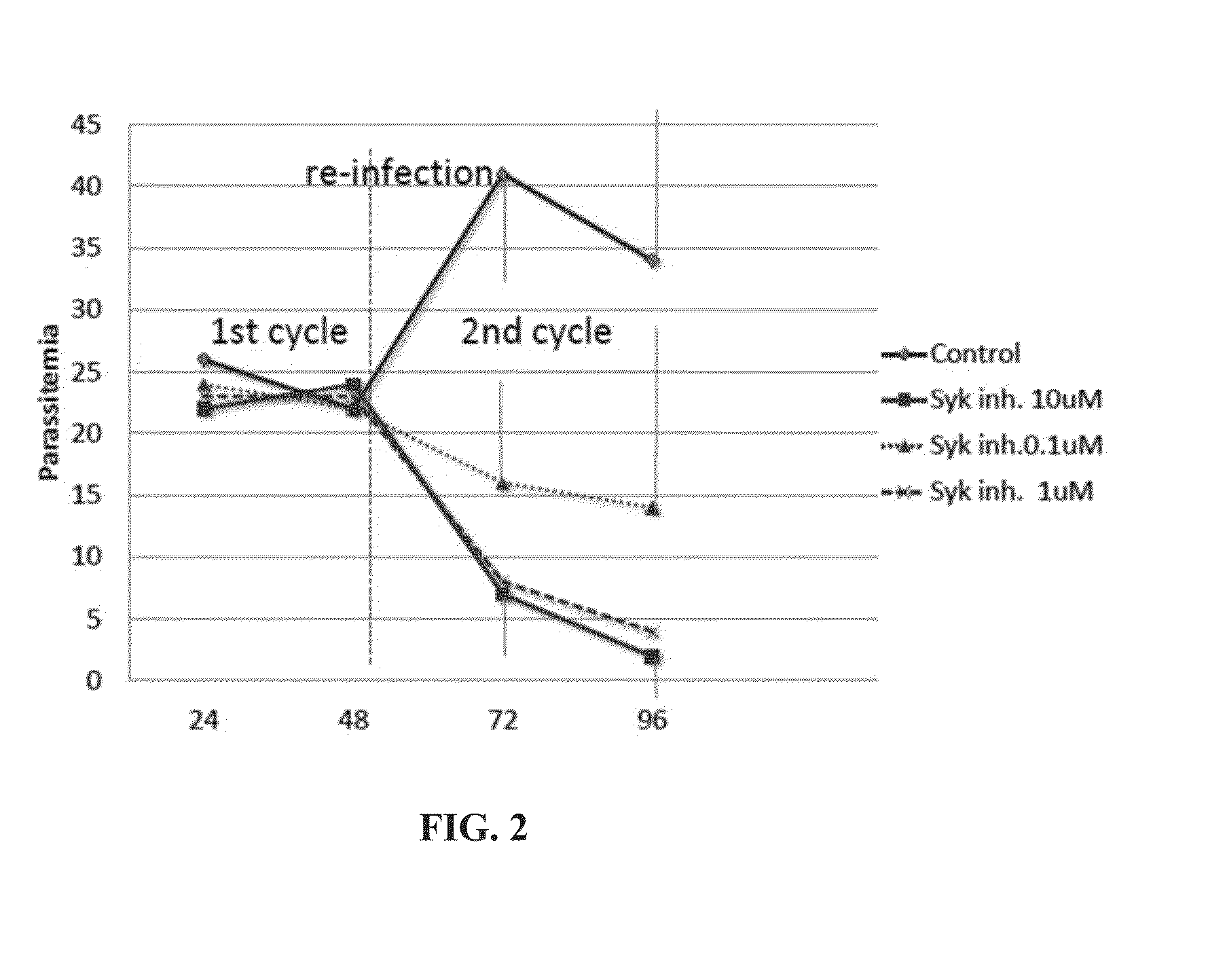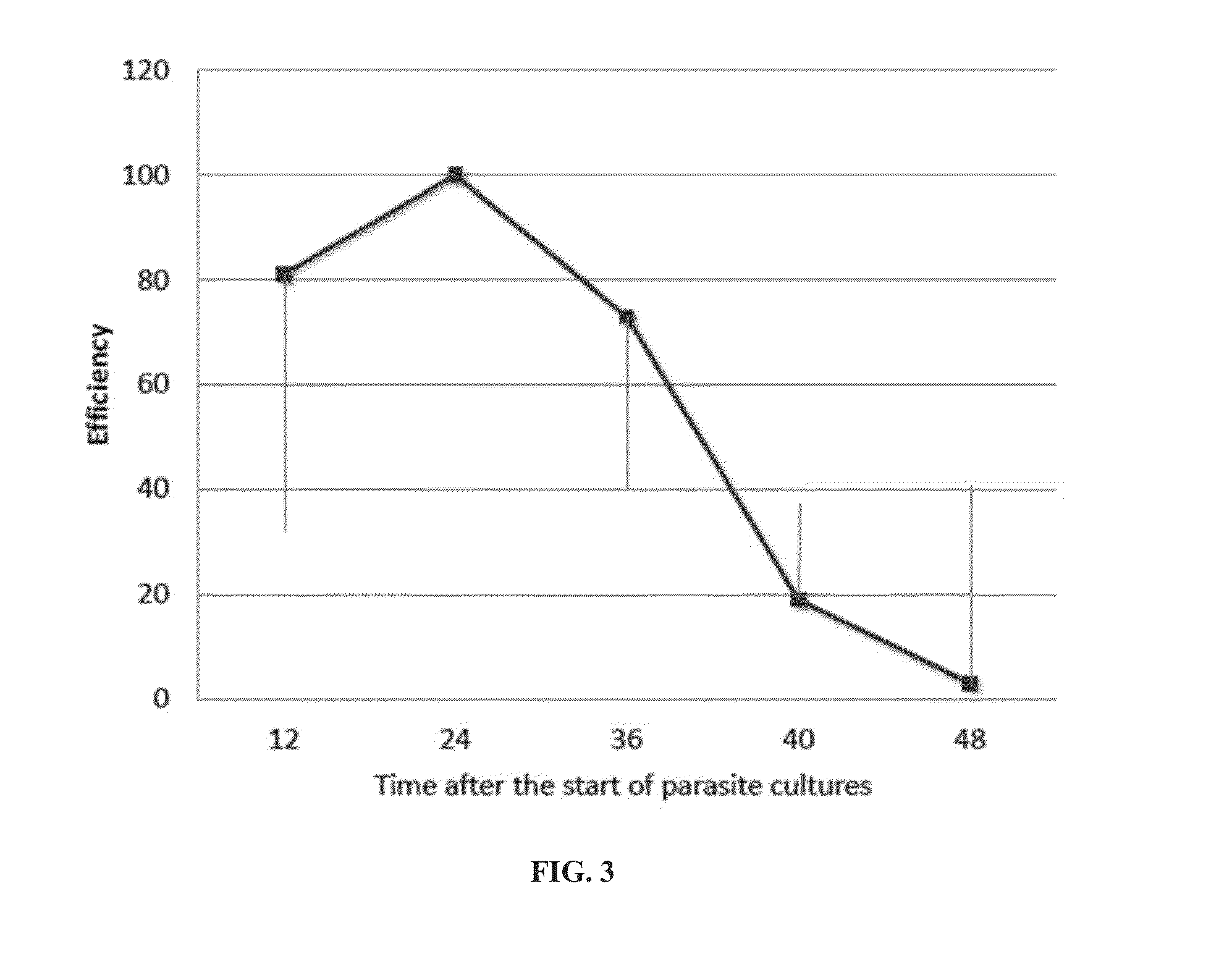Syk kinase inhibitors as treatment for malaria
a kinase inhibitor and malaria technology, applied in the field of malaria, can solve the problems of inability to tolerate inhibitors are too toxic for clinical use, and inhibitors that block the activity of parasite protein kinase would seem susceptible to mutagenic events, etc., and achieve the effect of being easily tolerated
- Summary
- Abstract
- Description
- Claims
- Application Information
AI Technical Summary
Benefits of technology
Problems solved by technology
Method used
Image
Examples
example 1
[0290]In this example, the following questions were addressed: (i) whether parasitized RBCs at the peak of their tyrosine phosphorylation have weakened erythrocyte membranes; (ii) if so, do they rely on this membrane weakening to complete their life cycle, and (iii) can inhibiting Syk kinase prevent the parasite from completing its life cycle?
Materials and Methods
[0291]Inhibition of Syk in RBCs.
[0292]Infected and non-infected RBCs were treated with Syk kinase inhibitor II (FIG. 2) at different concentrations and at different times after the start of the cultures.
[0293]Cultivation of P. falciparum-Infected RBCs.
[0294]Freshly drawn blood (Rh+) from healthy adults of both sexes was used following informed consent in all studies. To prevent coagulation, blood was treated with heparin and stored for 1-6 hours in citrate-phosphate-dextrose with adenine (CPDA-1) prior to its use. RBCs were separated from plasma and leukocytes by washing three times in wash medium (RPMI 1640 medium containi...
example 2
[0321]Integral membrane proteins provide the cell with a vital link to its environment. Because they are responsible for essential functions such as cell polarity, signal transduction, and vectorial transport, their targeting and placement is of critical importance. It is well accepted that their interactions with other proteins, such as those making up the cytoskeleton, are largely responsible for anchorage and stabilization at specific plasma membrane domains. Two of these membrane proteins are band 3 and Ankyrin.
[0322]Band 3 is a very abundant 93-kDa integral membrane glycoprotein that mediates chloride / bicarbonate exchange in erythrocytes. It is composed of two structurally and functionally distinct domains. The carboxyl-terminal 55 kDa spans the membrane at least 12 times, and is responsible for catalyzing the rapid exchange of anions across the plasma membrane. The 40-kDa NH2-terminal domain is cytosolic and directly interacts with high affinity with ankyrin, a 215-kDa cytosol...
example 3
[0339]In this Example, the ability of imatinib mesylate (Gleevec) to inhibit phosphorylation of Band 3 was tested.
[0340]Materials and Methods
[0341]Blood was collected from healthy volunteers after informed consent and immediately processed. Briefly, blood was centrifuged at 1200×g to separate red cells from the buffy coat and plasma, and subsequently washed three times in PBS (137 mM NaCl, 2.7 mM KCl, 8.1 mM K2HPO4, and 1.5 mM KH2PO4, pH 7.4) to remove any remaining white blood cells.
[0342]Packed erythrocytes were re-suspended at 30% hematocrit in PBS containing 5 mM glucose and treated with varying concentrations of Gleevec® (Santa Cruz Biotechnology). Stock solutions of Gleevec, prepared in double distilled water pH 5.5, were prepared fresh. Untreated control erythrocytes and Gleevec® treated red cells were incubated for 1 hour at 37° C.
[0343]To induce tyrosine phosphorylation, erythrocytes were then incubated with 2 mM orthovanadate and again incubated for 1 hour at 37° C. Cells ...
PUM
| Property | Measurement | Unit |
|---|---|---|
| Mass flow rate | aaaaa | aaaaa |
| Mass flow rate | aaaaa | aaaaa |
| Structure | aaaaa | aaaaa |
Abstract
Description
Claims
Application Information
 Login to View More
Login to View More - R&D
- Intellectual Property
- Life Sciences
- Materials
- Tech Scout
- Unparalleled Data Quality
- Higher Quality Content
- 60% Fewer Hallucinations
Browse by: Latest US Patents, China's latest patents, Technical Efficacy Thesaurus, Application Domain, Technology Topic, Popular Technical Reports.
© 2025 PatSnap. All rights reserved.Legal|Privacy policy|Modern Slavery Act Transparency Statement|Sitemap|About US| Contact US: help@patsnap.com



